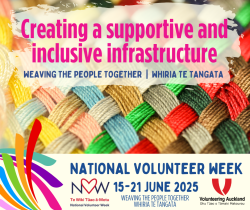Weaving the People Together: Creating an Inclusive and Supportive Infrastructure

Volunteering has long been a cornerstone of strong, connected communities. When done right, it weaves people together, fostering a sense of belonging and collective purpose. However, for volunteering to be truly effective in uniting people, community organisations must build an inclusive and supportive infrastructure that encourages participation from all sectors of society. Without this, barriers can prevent diverse groups from engaging in volunteer activities, limiting both its reach and impact.
The Need for Inclusive and Supportive Infrastructure
An inclusive and supportive infrastructure ensures that volunteering is accessible to people from various backgrounds, abilities, and socio-economic situations. It recognises and removes barriers that may prevent participation, such as rigid scheduling, lack of resources, or cultural misunderstandings. When community organisations create an environment that is welcoming, adaptable, and well-structured, they not only increase engagement but also maximise the benefits of volunteering for both individuals and the community.
Key Elements of Supportive Infrastructure in Community Organisations
1. Accessible Volunteer Opportunities
To be truly inclusive, volunteer roles must be flexible and accommodating. Many people who want to volunteer may have constraints such as full-time jobs, caregiving responsibilities, or mobility challenges.
Organisations can address this by:
- Offering a range of opportunities, including short-term, remote, and micro-volunteering roles.
- Providing options for evening and weekend participation.
- Using digital platforms to facilitate virtual volunteering, particularly for those in rural areas or with disabilities.
For example, some organisations provide flexible opportunities where volunteers can contribute remotely or on an as-needed basis, making it easier for a diverse range of individuals to participate.
2. Culturally Responsive Engagement
Different cultural groups may have unique expectations and preferences regarding volunteering.
To create a welcoming environment, organisations should:
- Work with cultural leaders to design roles that align with the values and traditions of various communities.
- Offer multilingual resources and translation services.
- Celebrate cultural events and include diverse voices in leadership positions.
In Aotearoa, Māori volunteering, or mahi aroha, is often informal and based on collective responsibility to the whānau (family) and hapū (sub-tribe). Organisations that recognise and incorporate these cultural perspectives into their volunteer programmes can foster greater engagement. For example, engaging with Māori communities through marae-based initiatives can enhance participation and inclusivity.
3. Strong Onboarding and Training Programmes
Volunteers are most effective when they feel prepared and supported.
A robust onboarding and training process should include:
- Clear role descriptions and expectations.
- Training sessions that equip volunteers with the necessary skills and knowledge.
- A mentorship or buddy system to help new volunteers feel welcomed and guided.
For instance, organisations like St John New Zealand provide structured training for volunteers in first aid and community support, ensuring they feel confident in their roles.
4. Recognition and Valuing Contributions
A strong sense of belonging is fostered when volunteers feel appreciated and recognised.
Effective strategies include:
- Regular thank-you events, such as volunteer appreciation days.
- Certificates, awards, and personalised acknowledgements.
- Highlighting volunteer stories on social media and newsletters.
Aotearoa New Zealand have various annual awards recognising outstanding contributions, helping to build a culture where volunteers feel valued and motivated.
5. Inclusive Policies and Governance
Creating an inclusive volunteering environment also requires inclusive leadership.
This can be achieved by:
- Ensuring diverse representation in decision-making roles.
- Developing policies that promote equity, such as covering transport costs for those with financial constraints.
- Establishing clear guidelines for addressing discrimination or accessibility concerns.
Organisations that actively involve marginalised groups in leadership decisions demonstrate a commitment to inclusivity and attract a broader volunteer base.
6. Building Strong Partnerships with Other Organisations
Collaboration enhances the effectiveness of volunteering by pooling resources and expertise.
Community organisations can partner with:
- Businesses to provide employee volunteering schemes.
- Schools and universities to engage young volunteers.
- Government agencies for funding and policy support.
For example, Volunteering Auckland collaborates with a range of stakeholders to support inclusive volunteering across Tāmaki Makaurau.
Conclusion
For volunteering to truly weave communities together, organisations must build inclusive and supportive infrastructure. This means offering accessible opportunities, embracing cultural diversity, providing strong training, recognising contributions, ensuring inclusive policies, and fostering collaboration. By implementing these strategies, community organisations can create environments where everyone, regardless of background or circumstance, feels empowered to contribute and connect through volunteering.
In doing so, we not only strengthen communities but also foster a society where collective action and mutual support thrive. The key is to ensure that no one is left behind in the process of giving back.

